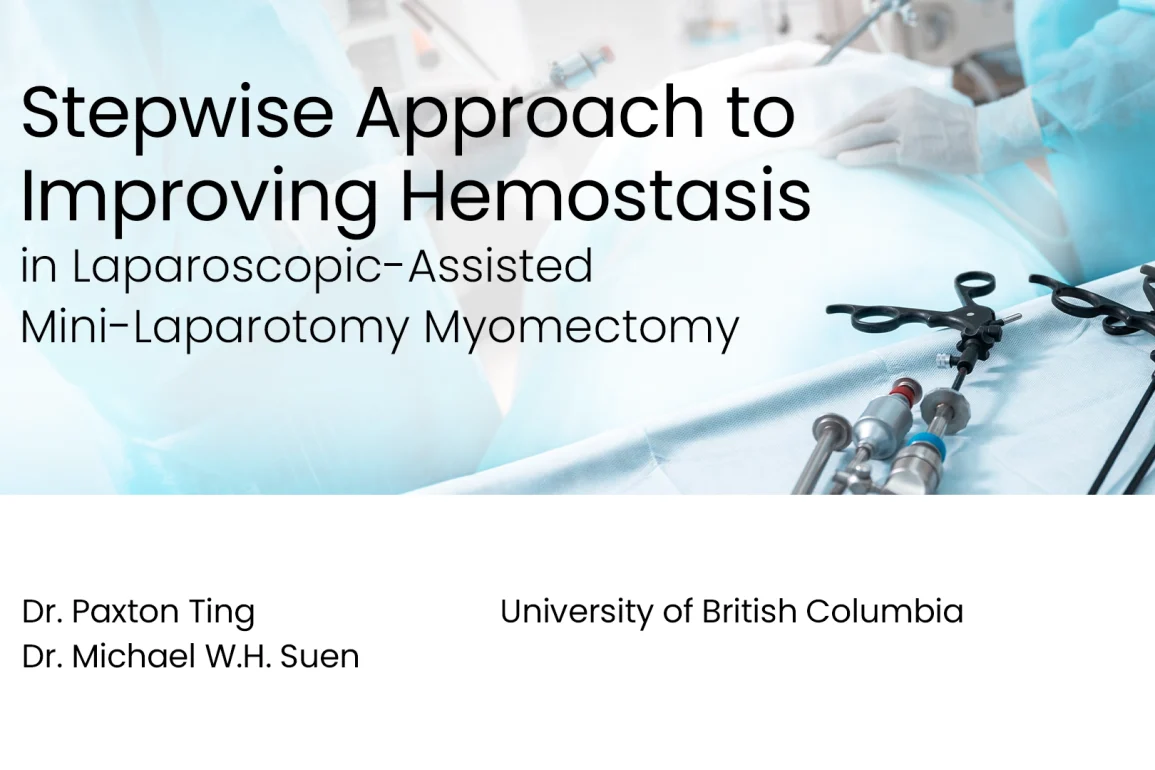Table of Contents
- Procedure Summary
- Authors
- YouTube Video
- What is Laparoscopic-Assisted Mini-Laparotomy Myomectomy?
- What are the Risks of Laparoscopic-Assisted Mini-Laparotomy Myomectomy?
- Video Transcript
Video Description
A stepwise technique to enhance hemostasis during laparoscopic-assisted mini-laparotomy, focusing on safety, visualization, and blood loss reduction.
Presented By


Affiliations
University of British Columbia
Watch on YouTube
Click here to watch this video on YouTube
What is Laparoscopic-Assisted Mini-Laparotomy Myomectomy?
Laparoscopic-assisted mini-laparotomy myomectomy is a combined surgical technique for removing uterine fibroids while minimizing blood loss and preserving the uterus for fertility. Here’s what it involves:
- Laparoscopic Survey and Planning: A laparoscopic inspection confirms fibroid size and location and ensures access for vascular control before proceeding with removal.
- Broad Ligament Window Creation: Avascular spaces in the broad ligament are carefully opened to identify the uterine vessels and protect the ureter.
- Cervical Tourniquet Placement: Jackson Pratt drain tubing is passed through the windows and tied around the cervix to temporarily occlude the uterine arteries and reduce blood flow to the uterus.
- Vasopressin Injection: Diluted vasopressin is injected along the planned uterine incision to constrict vessels and create a clear dissection plane.
- Mini-Laparotomy and Fibroid Removal: A small abdominal incision of about 4 cm allows direct enucleation, morcellation, and extraction of the fibroid while the uterus remains hemostatic.
- Uterine Repair and Barrier Placement: The myometrium is closed in multiple layers through the mini-laparotomy, the tourniquet is removed, and an anti-adhesion barrier is applied to reduce postoperative scarring.
This stepwise method combines laparoscopic visualization with a limited open incision, improving exposure, reducing bleeding, and facilitating efficient fibroid removal.
What are the Risks of Laparoscopic-Assisted Mini-Laparotomy Myomectomy?
Video Transcript:
This is a surgical video demonstrating the Stepwise Approach to laparoscopic assisted mini-laparotomy myomectomy, with a focus on improving haemostasis. The authors have no conflict of interest to disclose. The objective of this video is to illustrate a surgical technique to decreasing blood loss, using a cervical tourniquet at the time of laparoscopic myomectomy.
Uterine leiomyomas or fibroids are benign, smooth muscle neoplasms that typically originate from the myometrium, stemming from a single progenitor myocyte. They are oestrogen and progesterone sensitive tumours.
20 to 50% of patients with fibroids are symptomatic, causing abnormal uterine bleeding, iron deficiency anaemia, dysmenorrhoea and cramps, bulk symptoms and, or reproductive issues.
Impact depends on their size, location, and number. Patients who have failed medical treatments or fibroids affecting fertility, will require surgical management in the form of myomectomy.
Surgeries involving the uterus and fibroids can result in significant blood loss due to the abundant blood supply to these tissues. There is a 20% blood transfusion risk for myomectomy cases. A systematic review published in 2014, reviewed and compared different techniques to minimise intraoperative bleeding. Either pharmacological or mechanical, preoperatively or intra-operatively. Our technique relies on preoperative GnRH agonists, intra-myometrial vasopressin and cervical tourniquet.
Our case presentation is a 35 year old G0 female, presenting with abnormal uterine bleeding, anaemia, urinary symptoms, and infertility. An MRI shows a large type two to five, seven by eight, by seven centimetre fibroid, with distortion of the endometrial cavity.
Here, we’ll demonstrate a surgical technique for myomectomy that relies on first securing haemostasis laparoscopically. We begin by performing a laparoscopic survey, creating windows into the broad ligament. Followed by placement of a cervical tourniquet using JP drain tubing to temporarily occlude the uterine arteries.
This is followed by a myomectomy and morcellation of fibroid enclosure through a mini-laparotomy. Equipment needed for this technique is a Jackson Pratt drain tubing and a plastic ring retractor. We will now proceed to our surgical video.
We begin by performing a laparoscopic survey to correlate intraoperative findings of the fibroid size and location to prior imaging, ensuring the lower segment is amenable to application of cervical tourniquet. Here, we can see we have adequate access, both anteriorly and posteriorly. Starting with the right enter, broad ligament an incision is made, and the [unclear] was developed to the contralateral side.
With traction and counter traction, careful dissection into the avascular plane was performed, to minimise bleeding and staining of the retroperitoneal space. The right [unclear] space was further developed. The uterine vessels were identified and shown in red.
Using a [unclear] leaflet of the broad ligament is tented up to identify an avascular space, lateral to the uterine vessels. An incision was made, and a window is created with opposing traction, parallel to the vessels to minimise bleeding. The right pelvic side was also inspected, and the ureter can be seen vermiculating trans-peritoneally, highlighted in yellow.
The same steps were repeated to create a window in the left broad ligament. Re-inspected the left pelvic sidewall, and we were not able to identify the ureter trans-peritoneally. The retro to peritoneal space was explored, and the ureter was identified and highlighted in yellow, and the uterine artery highlighted in red.
A 4 cm mini-laparotomy is created. A small incision was made in the peritoneum laparoscopically to increase the ease of abdominal entry. A ring retractor is used to maximise visualisation of the fibroid during extraction of the specimen. It is also used to provide [unclear] occlusion once the mini-laparotomy is made.
A Jackson Pratt brain tubing is introduced into the abdomen through the mini laparotomy. We prefer to use a Jackson Pratt drain tubing for the cervical tourniquet, rather than other options, such as suture or fully tubing, for multiple reasons.
The flat end of the Jackson Pratt tubing provides just enough rigidity for easy manipulation of the tube through our broad ligament windows, as demonstrated here. A uterine manipulator is instrumental in deviating the uterus to provide visualisation through our broad ligament windows, so the other end of the tubing can be seen. The ends of the Jackson Pratt tubing is then brought through the mini-laparotomy for the knot to be placed.
The material of the tubing itself behaves like suture when tying the tourniquet down, where it can hold a knot well without slipping, and provide enough tension to apply pressure on the uterine vessels, while minimising trauma to the tissue. Penrose drain material stretches like elastic band without slipping down adequately for a strong knot. Lastly, this type of tubing is also silicone free.
A spinal needle is introduced into the abdomen, and diluted vasopressin is injected along the planned incision site. The diluted vasopressin and [unclear], constricts the superficial uterine vessels, feeding the fibroid and hydro dissects to create a plane for enucleation of the specimen.
An incision is made on the uterus to expose the fibroid. The fibre was impartially enucleated. Minimal blood loss can be seen and the uterine tissue remains blanched from the combination of vasopressin and inclusion of the uterine vessels from the tourniquet.
The uterus was then brought to the anterior abdominal wall for a complete enucleation and extraction of the fibroid through the mini-laparotomy. Once again, the uterus remains haemostatic through the morcellation process. The tourniquet works well, even when there are multiple, large and even massive fibroids. But not when there is a significant cervical or lower segment component that prevents either broad ligament windows or proper placement of the tourniquet. In this case, vascular bulldog clamps on the uterine artery or internal iliacs are employed.
A multi-layer closure of the myometrium is performed. We find it more efficient to suture through the mini-laparotomy. But in cases of a lower segment posterior fibroid, laparoscopic suturing is required. The tourniquet is then removed, and haemostasis is ensured.
Finally, a layer of anti-adhesive barrier was applied. The estimated blood loss was less than 100 cc’s.
Here is a flowchart summary of the technique described with the emphasis on step two and three, describing steps to improve haemostasis.
Thank you so much for watching this video, and we would like to thank our collaborator.


